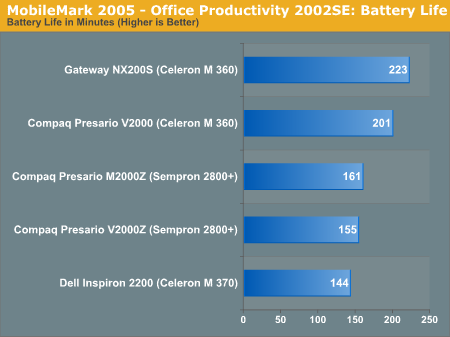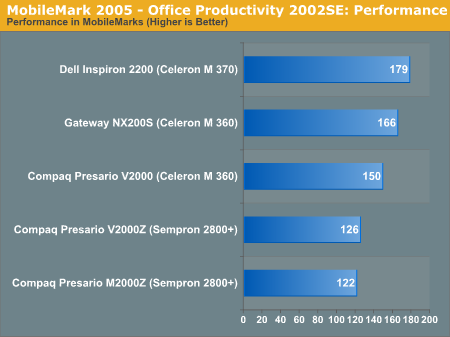$600 Notebook Roundup - Crowning the Affordability King
by Anand Lal Shimpi on November 29, 2005 10:38 AM EST- Posted in
- Laptops
Battery Life - Business Applications
While the performance of these laptops was very similar when running on AC power, unplugging them and focusing on battery life and performance changes the landscape dramatically. For our battery life tests, we turn to MobileMark 2005, which offers a total of four battery life measurement tools - the first one being the Office Productivity 2002SE benchmark.
The Office Productivity 2002SE benchmark does the following:
The workloads in this category model a mobile professional at a fictitious automobile company. The worker creates documents using Microsoft Word, Excel and PowerPoint, accesses email, and creates graphics and animation with Photoshop and Flash to include in a multimedia presentation. An Internet browser is used to view presentations. The user also invokes file compression and virus detection in the background.
It was also surprising to find out that neither of the Sempron based notebooks were really competitive at all in terms of battery life. The real race was between the Compaq Presario V2000 and the Gateway NX200S, which the Gateway won by just over 10%.
MobileMark 2005's Office Productivity 2002SE test also produces a performance score, to accompany the battery life metric in showing you how fast the notebooks were while on battery power:
While the performance of these laptops was very similar when running on AC power, unplugging them and focusing on battery life and performance changes the landscape dramatically. For our battery life tests, we turn to MobileMark 2005, which offers a total of four battery life measurement tools - the first one being the Office Productivity 2002SE benchmark.
The Office Productivity 2002SE benchmark does the following:
The workloads in this category model a mobile professional at a fictitious automobile company. The worker creates documents using Microsoft Word, Excel and PowerPoint, accesses email, and creates graphics and animation with Photoshop and Flash to include in a multimedia presentation. An Internet browser is used to view presentations. The user also invokes file compression and virus detection in the background.
Microsoft Word 2002: The user starts Microsoft Word and opens an eight-page assembly manual document for a new transmission system. The user sets paragraph formatting, font configuration and adds text to the document. The user inserts an image, a table of contents and a table of figures. Twenty additional images, ranging in size from 3 Kb to 15 Kb are inserted throughout the document. The user then adds a watermark to the document and performs a global find and replace. The document is printed and the user inserts a hyperlink into the document and adds more text. The user inserts a training video, changes the theme and saves the document in web page format. Later, the user returns to Word and opens a book to read. The user auto-summarizes the book to generate a shorter synopsis.
Microsoft Excel 2002: The user starts Microsoft Excel and opens a large spreadsheet (a 12 megabyte file with approximately 3000 rows and 248 columns of data). The user selects a group of formulae for data analysis. The user selects the data and performs a sort, using three key fields. This data is then used to create a chart, which is exported to a web page. The user then opens a different spreadsheet (an 8.5 megabyte file with approximately 2100 rows and 248 columns of data), and performs similar operations, resulting in another web page.
Microsoft PowerPoint 2002: The user starts Microsoft PowerPoint and opens a 24 slide presentation of the previous quarter's news and sales. The user moves through the presentation inserting and positioning several images (47 to 57 kilobytes in size). Upon completing this, the presentation is checked for spelling errors. The user then applies different themes/backgrounds to the presentation and selects one. Finally, the user reviews the material in slide show mode and exports the finished presentation to web page format.
Microsoft Outlook 2002: The user starts Microsoft Outlook and opens the inbox, changing the view mode to show the first lines of each message. The email editor, Word, is launched, and a document is opened, printed, and sent to an email recipient. The user then opens one of the documents in the inbox, adds a picture as an attachment, and emails it. Moving to the Draft folder, the user opens three email messages: the first has its spelling checked and is sent, the second is sent and the third is checked for spelling, summarized and sent. Three more messages are created and sent with attached images. Finally, the user compresses the Outlook offline folder.
Netscape Communicator 6.01: The user opens the Netscape browser and loads an HTML version of a Word document. The source HTML code is then viewed. The user also views two charts exported to HTML from an Excel file. Finally, the user browses through a 15-page PowerPoint slide show that was saved in HTML format.
WinZip Computing WinZip 8.0: The user creates a compressed data file from a set of bitmap files (7.6 megabytes total size) in a specific folder. The resulting .zip file is 54% of the size of the original group of files. Once started, the user moves this to the background and works with other applications.
McAfee VirusScan 5.13: The user scans program files (3,110 files and 438MB) for the presence of viruses. This is run in the background as the user works.
Adobe Photoshop 6.0.1: The user starts Adobe Photoshop and sets the workplace. A 7.12MB high-definition source file is opened and the image is sized to fit in the window. The user performs image manipulations, including Smart Blur, Distort Wave, and rotation. Finally, the user re-sizes the image and adjusts the image color levels before saving the image as a web-friendly 20kilobyte JPEG file.
Macromedia Flash 5: The user creates a Flash animation using text, graphics and still images. The user works in an existing Flash animation, adding, then manipulating and positioning a new image to appear appropriately within the final animation. To do this, the user starts Macromedia Flash and opens a preconfigured project (FLA) file, containing 23 different layers. The user moves down to one of the layers in the project file, deletes the key frame and imports a new image of a person in a kayak (a 24-bit color, 72 dpi, 300 x 211 resolution PNG format image with transparency). This image is then manipulated (rotated, flipped) and positioned appropriately within the frame and is then grouped into an instance. Finally, the user exports the animation to a web ready SWF file using 100 percent jpeg compression.

It was also surprising to find out that neither of the Sempron based notebooks were really competitive at all in terms of battery life. The real race was between the Compaq Presario V2000 and the Gateway NX200S, which the Gateway won by just over 10%.
MobileMark 2005's Office Productivity 2002SE test also produces a performance score, to accompany the battery life metric in showing you how fast the notebooks were while on battery power:











50 Comments
View All Comments
Hacp - Tuesday, November 29, 2005 - link
x200 graphics with/o dedicated memory.If you get x300 graphics with some dedicated memory, it should play some of hte latest games at halfway acceptable settings. Just dont' expect to be playing FPS smoothly though, but RPGs/rts should be fine. Racing should be fine too.
manno - Tuesday, November 29, 2005 - link
meLoneWolf15 - Tuesday, November 29, 2005 - link
Interesting to note that even without Speedstep, the Celeron-M still has better battery life. Then again, didn't Intel change some designs in transistor-switching to make battery performance better even at full speed?One comment, more to notebook manufacturers: Where the heck is my Trackpoint mouse? I can't stand touchpads, which require me to take my fingers off the keyboard to use, when a trackpoint can be used almost simultaneously. I can type 75-80wpm, and don't find touchpads very efficient for this reason (my older but top-of-the-line-when-released Latitude C840 has both devices). Somebody, please bring back the Trackpoint!
Hacp - Tuesday, November 29, 2005 - link
Also, why do you have to take your fingers of the keyboard to use the touchpad? I keep one hand on the keyboard, and one hand on the touchpad when using my computer. Rightclick is tap top right corner, leftclick is tap anywhere on the touchpad that doesn't involve the top right corner.Zorba - Tuesday, November 29, 2005 - link
I too hate touchpads and miss the old mouse sticks. I always rub the touchpad with my arm when typing and usually end up clicking some where I don't want to. It also takes me much longer to navigate with a touchpad and I usually accidently click something because I change the amount of pressure on the pad (I know you can turn the clicking off, but I still don't like the pad). It is a personal preference but I would like to at least be given the chance to pick between the two.matthewfoley - Tuesday, November 29, 2005 - link
Yeah, well I hate the mouse sticks. Who cares.Zorba - Tuesday, November 29, 2005 - link
The point the original poster and I were trying to make is manufacturers should include both devices, which a lot of them used to do.Hacp - Tuesday, November 29, 2005 - link
The battery life difference is most likely due to the ATI chipset and integrated graphics, which uses more power than intel EE.Tamale - Tuesday, November 29, 2005 - link
page 9's link to page 10 is shotTamale - Tuesday, November 29, 2005 - link
nvm :]